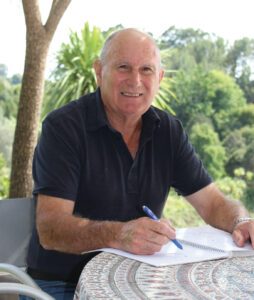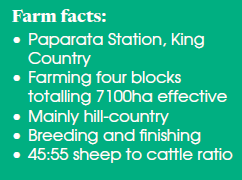Cow power rules
Angus or Angus-Hereford cows are the stock of choice on Paparata Station, Mike Bland writes.

Angus or Angus-Hereford cows are the stock of choice on Paparata Station, Mike Bland writes.
King Country farmer Trevor Johnson has always been an enthusiastic advocate for beef cows on hill-country.
With wife Trish he owns Paparata Station, an operation that farms 65,000 stock units on 7100-hectares effective in the Tokirima and Ohura districts.

“The nature of the contour here means it’s difficult to subdivide, so it’s hard to maintain pasture quality. But the cows have the ability to turn spring pasture growth into winter feed by carrying surplus condition into winter.”
Trevor says feed that’s not utilised during the November/December period ends up as poor quality pasture that has to be removed in autumn and winter.
“Cows will clean up this low quality feed, and they can take a knock if things get tight without sacrificing a lot of production.”
The Johnsons’ business spans four blocks – 2420ha Paparata, 1400ha Tokirima, 1730ha Heao and 1550ha Te Moata. Stock farmed by the Paparata Group includes 30,000 Romney ewes and in-lamb ewe hoggets, 2700 cows, 2200 R1 cattle and 500 R2 steers.
The beef herd on recently-acquired Te Moata is largely Angus, and the other farms carry mostly Angus-Hereford cows.
Trevor, who was raised on the Tokirima block, says beef cows are crucial to the success of the operation.
The Paparata Group runs a 55:45 sheep to cattle ratio, which means Paparata farms are probably carrying higher cattle numbers than other similar properties in the region.
“But for us that’s an ideal ratio to maintain pasture quality. It’s easy to justify a high cattle ratio because it lifts our sheep production. The beef cows complement our sheep.”
Cows were used as a development tool initially, breaking in country that was previously covered in ringfern. Cow numbers have increased steadily since 1998.
“During the 1990s we experimented with reducing beef cow numbers and increasing the number of dry cattle. We bought reared calves, but the end result was that using dry cattle to clean up hills was expensive. Liveweight losses had to be rebuilt and this meant stock was effectively grazed for no return. The delay in getting them to market weights came at a financial cost and the venture didn’t prove worthwhile.
“The difference between breeding cows and drystock is that the cows have the ability to consume that extra feed in late spring and put weight on their backs. In winter we can use them to tidy up surplus growth and improve pasture quality, but if things get tight they can lose 50kg of liveweight without any problems further down the track. There’s usually no financial cost in doing this because they recover that weight loss in spring, prior to mating.”

Friesian bulls used
In the 1990s Trevor and his management team introduced a recording and tagging system to identify top producing cows and sires. Friesian bulls were used over Angus-Hereford cows and production increased due to better genetics and the benefits of hybrid vigour from the three-way cross.
But over the past 10 years the station has gone back to Angus-Hereford. Trevor says while the milking ability of the Friesian was beneficial, Friesian-cross cows were harder to manage through winter.
“They were producing too much milk, their udders were getting too big and their progeny were harder to sell.”
He believes the mix of two traditional beef breeds provides the perfect combination for hill- country conditions.
“We are still getting a 15-16% gain from hybrid vigour, and the main advantages of the beef-sired animals are their hardiness and their ability to increase liveweight over the spring-summer period.”
All calves are tagged at birth – Herefords with a blue tag and Angus with yellow. Blue-tagged cows and heifers are mated to Angus sires and the yellow tags go to a Hereford.
Paparata buys about 30 bulls annually. Angus sires are sourced from the Stokman and Waitangi studs and Herefords come from Craigmore and Kokonga.
Trevor and his team look for easy-calving bulls that provide high growth rates.
“We don’t want a high birth-weight because we are calving cows in the hills. So we look for Angus bulls with a birth-weight EBV of between three and five, and a 600-day growth-rate of 110 or higher. For the Herefords we want a birth-weight EBV of four to five and a 600-day growth-rate of 70 or over.”
Paparata sells about 2200 cattle a year – about half steers and the rest cows and heifers. Surplus progeny are finished or sold store. Steers are sold as yearlings in December or carried through to two years of age and finished at 310-330kg carcaseweight (CW).
As part of a strategy designed to counter increasingly dry summers, fewer steers will be finished in future.
Trevor says annual rainfall has fallen below 1300mm during the last three years.
“At the moment we are looking to sell over half of the steers as yearlings and that will help take the pressure off the farm in summer.”
All heifers are mated at a minimum of 300kg and surplus heifers are sold in November-December.
While the cattle are regarded as vital for maintaining pasture quality on Paparata’s steep hills, one of the disadvantages of carrying large numbers of breeding cows on heavy mudstone soils is the amount of pugging damage in winter.
Trevor says management has changed to reduce pressure on the hills.
In the past, mobs of 200-plus cows have been rotationally grazed around the hills, but mob stocking is now avoided wherever possible.
Prior to calving, cows are instead set-stocked with the ewes in the hills at about one cow every two hectares. They calve in November.




